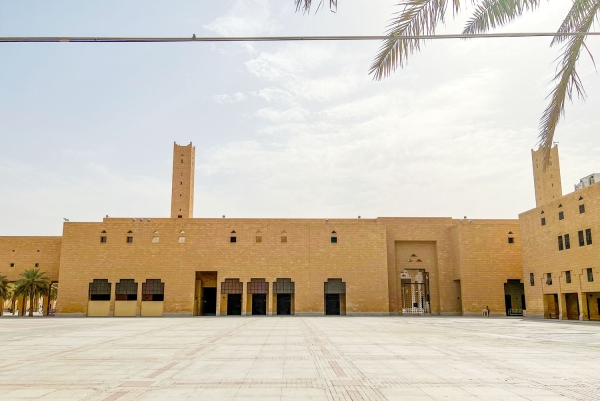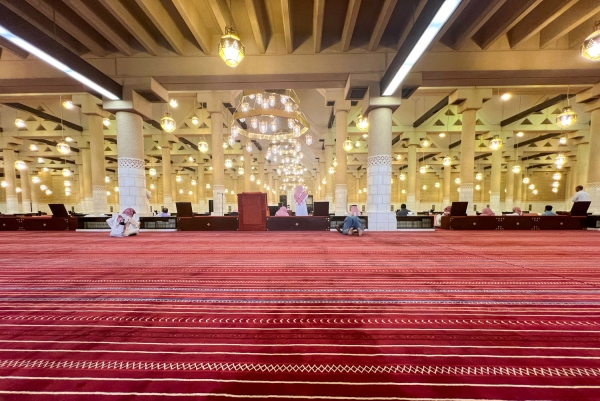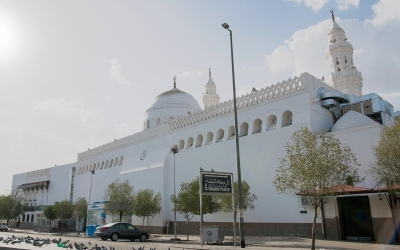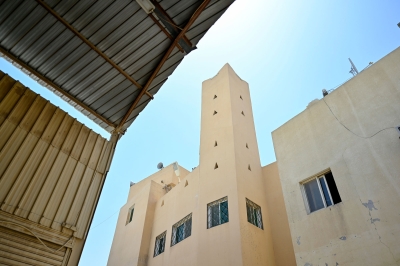


Imam Turki Bin Abdullah Grand Mosque, is a historic mosque in the al-Hukm Palace District at the center of Riyadh City, Kingdom of Saudi Arabia. It was built during the reign of Imam Turki Bin Abdullah Bin Mohammed Bin Saud, the founder of the Second Saudi State.
Establishment of Imam Turki Bin Abdullah Grand Mosque
Imam Turki Bin Abdullah Grand Mosque was constructed on land known as "al-Na'qa" in central Riyadh during the reign of Imam Turki Bin Abdullah (1824-1834). He commissioned its construction near al-Hukm Palace and several neighborhoods, envisioning it as a scientific institution. He appointed Abdulrahman Bin Hassan Al al-Sheikh as its supervisor and head of scholars. Imam Turki customarily exited the mosque after Friday prayers through a door located south of the Mihrab, designed for his entry and exit in the mosque’s Qibla, as well as that of the mosque's imam.
During the reign of Imam Faisal Bin Turki Bin Abdullah, specifically in 1844, the mosque was rebuilt and expanded on both its eastern and western sides. He also introduced Islamic decorations unknown in Najd at the time. Additionally, he constructed an upper passageway linking the mosque to al-Hukm Palace, complete with channels, and built a long, covered corridor supported by columns to further connect the two structures.
Care of Imam Turki Bin Abdullah Grand Mosque in the modern Saudi era
The Founding King Abdulaziz Bin Abdulrahman Al Saud took special care of Imam Turki Bin Abdullah Grand Mosque, expanding its area and connecting it to al-Hukm Palace via a bridge to facilitate access during daily and Friday prayers. He also ensured the mosque was lit.
During the reign of King Saud Bin Abdulaziz, this care continued, leading to further construction, refurbishment of its furniture, and lighting. The mosque's area was expanded, and traditional building materials such as mud and dried mud bricks were used, with roofs made of palm trunks and stones.
The care of the mosque remained during the reigns of King Faisal Bin Abdulaziz Al Saud and King Khalid Bin Abdulaziz Al Saud through modern construction. It underwent a second expansion, by restoring it, increasing its size, and furnishing it.
Development of Imam Turki Bin Abdullah Grand Mosque
The Royal Commission for Riyadh City (RCRC) reconstructed the mosque at its original site as part of its initiative to develop al-Hukm Palace District in central Riyadh City. Inaugurated in 1993, the mosque spans approximately 16,800 m and accommodates up to 17,000 worshipers. It features a prayer hall for men and a separate hall for women, covering 6,320 m, with a height of 14.8 m. Additionally, it includes an external courtyard of 4,800 m and two minarets, rising 50 m. It also houses accommodations for the imam and muezzin, offices for government agencies, and two libraries for men and women.
Constructed using precast concrete units, the mosque’s exterior walls and upper interior sections are clad in Riyadh stone, while the lower walls and columns are adorned with white marble. The ceiling is covered with concrete tiles designed to resemble the wooden panels that once adorned the original mosque. Equipped with modern broadcasting technology, the mosque features remote-controlled television cameras for live radio and television transmission. The mosque received the global Aga Khan Award for Architecture in 1995 during the award ceremony held in Solo, Indonesia.
Imams and muezzins of Imam Turki Bin Abdullah Grand Mosque
The mosque had several sheikhs and imams over the years, including: Abdulrahman Bin Hassan Bin Mohammed in 1826, Abdulatif Bin Abdulrahman Bin Hassan in 1869, Mohammed Bin Ibrahim Bin Mahmoud in 1876, Abdulaziz Bin Saleh Bin Musa Bin Murshid, Abdullah Bin Abdulatif Al al-Sheikh, Abdulrahman Bin Mohammed Bin Asaker (who served as acting imam during Abdullah Bin Abdulatif Al al-Sheikh’s illness), Abdulrahman Bin Abdulatif (who served as acting imam for six months during Abdullah Bin Abdulatif Al al-Sheikh’s illness), Mohammed Bin Abdulatif Bin Abdulrahman Al al-Sheikh, Omar Bin Abdulatif in 1945, Saad Bin Atiq, Abdulrahman Bin Abdulatif (second tenure until 1947), Abdullah Bin Abdulrahman Bin Abdulatif, Ibrahim Bin Suleiman Al Mubarak, Abdulrahman Bin Awdan in 1951, Mohammed Bin Ibrahim Al al-Sheikh, Mufti al-Diyar, from 1954 until his death in 1969, Abdulaziz Bin Abdullah Bin Baz from 1969, Abdullah Bin Abdulrahman Bin Jibrin (acting imam) in 1999, the Grand Mufti of the Kingdom of Saudi Arabia, Sheikh Abdulaziz Bin Abdullah Al al-Sheikh, and Mohammed Bin Abdullah Bin Omar Al al-Sheikh (who served as acting imam in the absence of Sheikh Abdulaziz Bin Abdullah Al al-Sheikh).
Among the mosque’s past imams was Abdullah Bin Mohammed Bin Nasban, who was blind. The mosque was named after him, becoming known as al-Nasibi Mosque. He led the prayers for approximately sixty-two years until his passing in 1992.
Related quizzes
Related articles

